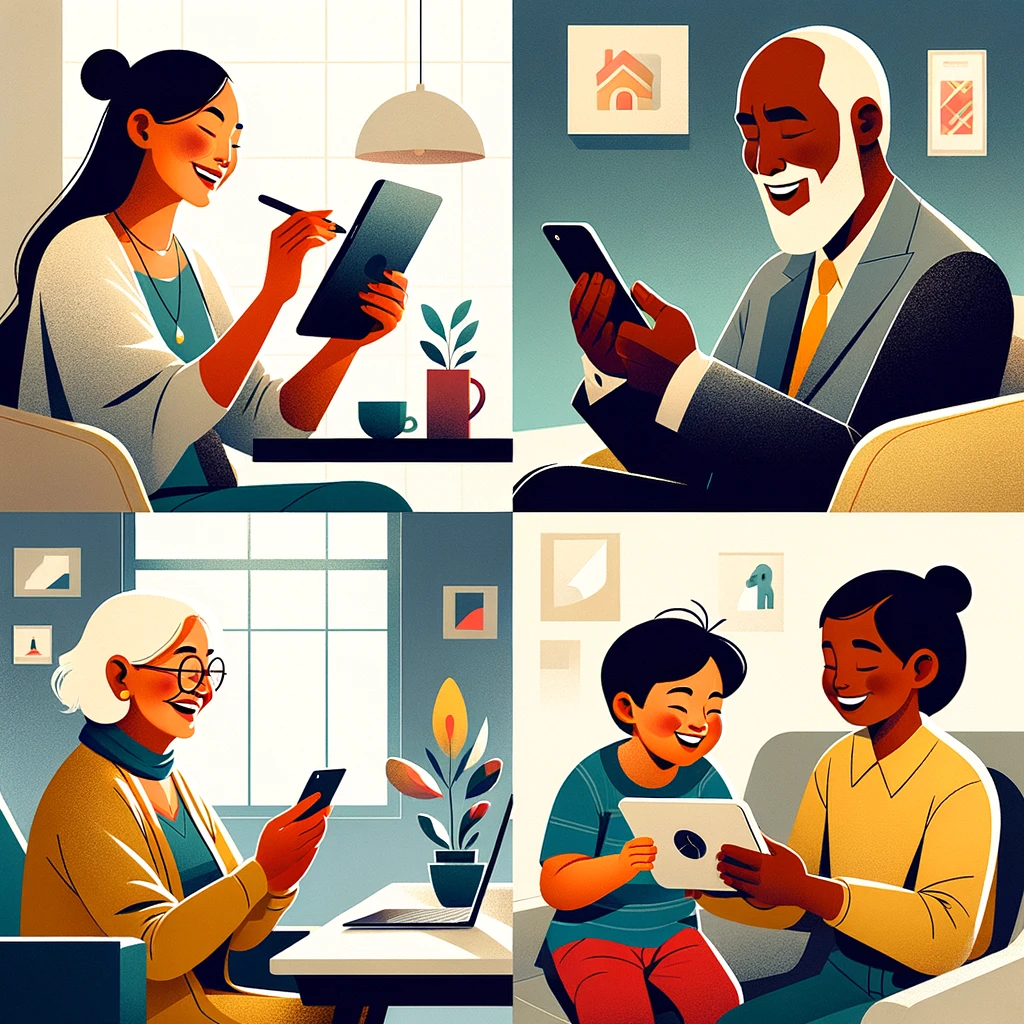Main takeaway – Go to section “Working on a UX project” to get started ASAP.
Introduction👋
Whether you’re new to the world of user experience (UX) design and want to land your first job, or want to give your UX career a boost – your portfolio is your best friend. This guide is here to help you step by step. Let’s get started on building your UX portfolio together!
What is UX Design? 🤔
UX design is making things work well and look good for people using your product. It’s about creating something so intuitive that it makes sense to people from all walks of life without needing an explanation.

Let’s explore some key principles and concepts that form the foundation of this field:
User-Centered Design: At the heart ❤️ of UX design is the idea that everything should revolve around the user. Your designs should prioritize the needs, preferences, and behaviors of the people who will use your product. Think about how to make their experience as seamless and satisfying as possible.
Intuitive Interaction: As mentioned earlier, an intuitive design should be so clear and easy to use that it requires no explanation. Users should be able to navigate your website, app, or product effortlessly, regardless of their background or familiarity with the interface.
Usability: Usability is all about ensuring that your design is practical and efficient. Can users accomplish their tasks without frustration? Is the interface user-friendly? Usability testing and research play a crucial role in fine-tuning your designs.
Consistency: Consistency is key to a good user experience. Elements like buttons, icons, and navigation should be consistent throughout your design, creating a sense of familiarity for users.
Accessibility: An inclusive design is one that can be used by everyone, including those with disabilities. Consider factors like color contrast, text size, and screen readers to ensure your design is accessible to a wide audience.
Information Architecture: Think of your design as a well-organized library 📚. Information should be structured logically, making it easy for users to find what they need. Clear labels, menus, and content hierarchy are essential components.
User Feedback: Listening 🧏♂️to user feedback is a valuable practice. By collecting feedback and making improvements based on it, you can continuously enhance your designs to better meet user expectations.
These principles and concepts will serve as your guiding lights as you embark on your journey to create a UX portfolio. As you build your projects and showcase them in your portfolio, remember to apply these principles to create designs that not only look great but also provide an exceptional user experience. In the next section, we’ll explore how to set clear goals for your portfolio.
Identifying Relevant Past Work for Your UX Portfolio 🕵️♀️
Begin by delving into your archives, including class assignments, personal projects, or any work you’ve done in related fields. While they may not be explicitly UX projects, they often contain elements that can be repositioned to showcase your UX skills.

For example:
Content Development: If you’ve created content, such as articles 📝, blog posts, or multimedia presentations, emphasize how you considered readability, accessibility, and user engagement in your content strategy.
Customer Service Initiatives: Past experiences in customer service or client interactions can be repurposed to showcase your communication and empathy skills, both essential in understanding user needs.
Class Assignments: Projects from coursework, such as research papers, can be repositioned to emphasize your research and analytical skills 📊, which are valuable in UX design.
Selecting UX Design Tools 🔨
Choosing the right tools is crucial for effectively presenting your UX work in your portfolio. Here are some essential tools to consider:
- Canva.com: If you’re new to UX design and looking for an easy-to-start tool, Canva is an excellent choice. It’s user-friendly and offers a range of templates and design elements, making it simple to create visually appealing graphics and infographics to enhance your portfolio.
- Bubble.io: Ideal for building interactive prototypes and web applications without coding. It’s an excellent choice for showcasing your UX skills with functional prototypes.
- Figma: A versatile, industry-standard tool for collaborative design and prototyping. You can create interactive prototypes and design user interfaces while collaborating in real-time.
Working on a UX project 🚀
It’s time to roll up your sleeves and get some experience with user experience (pun intended).

1. Choose a UX Challenge: Begin by selecting a UX challenge that aligns with your interests and goals. Two excellent resources for finding UX challenges are UX Tools and UX Challenge. These platforms offer a variety of fictious scenarios and problem statements to practice and work on. Here’s an example of one of my projects:
2. Understand the Problem: Before jumping into design, take the time to thoroughly understand the problem at hand. Research the context, identify user pain points, and define clear objectives for your project. This foundational step is essential for effective UX design.
3. Conduct User Research: User research is a cornerstone of UX design. Use techniques like user interviews, surveys, or usability testing to gather insights directly from your target audience. Understanding their needs and behaviors will guide your design decisions.
4. Sketch and Ideate 🎨: Put your ideas on paper or create rough digital sketches. Brainstorm different solutions to the problem and explore various design concepts. This phase encourages creativity and innovation.
5. Create Wireframes and Prototypes: Move on to creating wireframes and low-fidelity prototypes. Prototypes will help you test your concepts and gather feedback.
6. Iterate and Refine 🔄: Don’t be afraid to iterate. Based on feedback from user testing, refine your designs, make necessary adjustments, and continue testing until you achieve an optimal user experience.
7. Document Your Process: Throughout your project, document your design process, challenges faced, and decisions made. These insights can be valuable additions to your portfolio, demonstrating your problem-solving skills.
8. Seek Feedback 💬: Don’t hesitate to seek feedback from mentors, peers, or the UX community. For instance, check out: https://www.reddit.com/r/userexperience/. Constructive feedback can help you refine your work and improve your skills.
By actively working on UX challenges, you’ll gain practical experience, build a diverse portfolio, and develop a deeper understanding of UX design principles. These projects will serve as valuable examples of your abilities when you showcase your work to potential employers or clients. Remember that the journey of hands-on experience is a key step toward building a successful career in UX design.
Structuring Your Portfolio 🧾
Organizing your UX portfolio is essential to effectively showcase your work and skills. Here’s a suggestion for a structured approach to help you present your projects in a compelling and organized manner:
1. Introduction: Begin with a concise and engaging introduction. Briefly introduce yourself, your passion for UX design, and what visitors can expect to find in your portfolio.
2. Project Overview: For each project, provide a brief overview that includes the project’s name, your role, the problem you aimed to solve, and the tools you used. This section should give viewers a quick glance at what to expect.
3. Problem Statement 📣: Clearly define the problem or challenge that your project aimed to address. Use real-world scenarios or user pain points to illustrate the significance of the problem.
4. User Research: Detail the user research methods you employed, such as user interviews, surveys, or usability testing. Explain how your research findings informed your design decisions.
5. Design Process: Walk your audience through your design process, from ideation to wireframing and prototyping. Describe the iterations and refinements you made along the way.
6. Visual Design: Showcase the visual elements of your project, including high-fidelity mockups, color schemes, typography choices, and any branding elements. Highlight how your design choices align with user preferences and usability.
7. Interaction Design: Explain the user interactions you implemented in your project, such as navigation, buttons, or interactive elements. Use visual aids or animations to illustrate these interactions.
8. Testing and Feedback ❌✔️: Share the results of user testing and feedback. Describe how you collected and incorporated user input to improve the user experience.
9. Outcomes and Impact: Discuss the outcomes of your project. Did it meet its objectives, and how did it impact the user experience or the business? Use data and metrics if available.
10. Lessons Learned🎓: Reflect on the lessons you gained from the project. Share any challenges you faced and how you overcame them. This section showcases your adaptability and problem-solving skills.
11. Project Conclusion 🏆: Summarize the key takeaways from each project and highlight what you learned. Emphasize how the project contributes to your overall growth as a UX designer.
Templates for Structuring Your Portfolio: If you’re looking for templates to structure your portfolio, you can find a variety of options on platforms like Canva, https://www.canva.com/presentations/templates/portfolio/.
Structuring Your Portfolio for a User-Friendly Experience
Think of your portfolio as more than just a showcase; it’s an interactive journey that tells a captivating story of your growth as a UX designer. You can treat the portfolio itself as a user experience project – it should be so intuitively designed that even navigating your portfolio becomes a delightful user experience. You can find examples of portfolios here: www.uxdesigninstitute.com/blog/inspirational-ux-design-portfolios
Conclusion 🏁
Congratulations on taking the first steps toward creating your UX portfolio! Remember, the most important thing is to just get started. Within 30 minutes from now, you could (and should) be actively working on one of the UX challenges, putting your newfound knowledge into practice.
______________________________________
I’d love to hear your thoughts, leave a comment down below <3
Credits: DALL·E 3 for the images and GPT-4 for making the text more readable

Leave a Reply